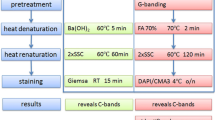Abstract
A method that allows the performance of double-colour chromosome painting (FISH) on previously G-banded human sperm metaphases has been developed. Sperm chromosomes were obtained by using the fusion technique between zona-free hamster oocytes and human spermatozoa. Single- and double-colour chromosome painting was performed using DNA libraries specific for chromosomes X, Y and 21 on either unstained or G-banded preparations. The hybridization efficiency was very high (98%). The sequential staining technique is very useful for analyses of structural (stable) and numerical chromosome aberrations in human sperm and thus can increase the efficiency of the human sperm—hamster oocytes fusion system to assess the risk to human germ cells as a result of endogenous and exogenous factors.
Similar content being viewed by others
References
Babu VR, Wiktor A (1991) A fluorescence in situ hybridization technique for retrospective cytogenetic analysis. Cytogenet Cell Genet 57: 16–17.
Benet J, Genescà A, Navarro J, Egozcue J, Templado C (1986) G-banding of human sperm chromosomes. Hum Genet 73: 181–182.
Benet J, Navarro J, Genesc BA, Egozcue J, Templado C (1991) Chromosome abnormalities in human sperm after albumin or Test-Yolk capacitation. Hum Reprod 6: 369–375.
Brandriff B, Gordon L, Ashworth L, Watchmaker G, Carrano A, Wyrobek A (1984) Chromosomal abnormalities in human sperm: Comparisons among 4 healthy men. Hum Genet 66: 193–201.
Brandriff B, Meistrich ML, Gordon LA, Carrano AV, Liang JC (1994) Chromosomal changes in the sperm of patients surviving Hodgkin's disease following MOPP (nitrogen mustard, vincristine, procarbazine and prednisone) therapy with and without radiotherapy. Human Genet 93: 295–299.
Jalal SM, Law ME, Christensen ER, Spurbeck JL, Dewald GW (1993) Method for sequential staining of GTL-banded metaphases with fluorescent-labeled chromosome-specific paint probes. Am J Med Genet 46: 98–103.
Klever M, Grond-Ginsbach C, Schertham H, Schroeder-Kurth TM (1991) Chromosomal in situ suppression hybridization after Giemsa banding. Hum Genet 86: 484–486.
Martin RH (1983) A detailed method for obtaining preparations of human sperm chromosomes. Cytogenet Cell Genet 35: 252–256.
Martin RH, Lin CC, Wayne B, Burns K (1982) Direct chromosomal analysis of human spermatozoa: preliminary results from 18 normal men. Am J Hum Genet 34: 459–468.
Martin RH, Hilderbrand K, Yamamoto J, Rademaker A, Barnes M, Douglas G, Arthur K, Ringrose T, Brown IS (1986) An increased frequency of human sperm chromosomal abnormalities after radiotherapy. Mutat Res 174: 219–225.
Martin RH, Spriggs E, Ko E, Rademaker AW (1995a) The relationship between parental age, sex ratios, and aneuploidy frequencies in human sperm, as assessed by multicolor FISH. Am J Hum Genet 57: 1395–1399.
Martin RH, Rademaker AW, Leonard NJ (1995b) Analysis of chromosomal abnormalities in human sperm after chemotherapy by karyotyping and fluorescence in situ hybridization (FISH). Cancer Genet Cytogenet 80: 29–32.
Mikamo K, Kamiguchi Y, Tateno H (1990) Spontaneous and in vitro radiation-induced chromosome aberrations in human spermatozoa: Application of a new method. In: Mendelsohn ML, Albertini RJ (eds) Mutation and the Environment, Part B: Metabolism, Testing Methods and Chromosomes. New York: Wiley-Liss, pp. 447–456.
Natarajan AT, Vyas RC, Darroudi F, Vermeulen S (1992) Frequencies of X-ray induced chromosome translocations in human peripheral lymphocytes as detected by in situ hybridization using chromosome-specific DNA libraries. Int J Radiat Biol 61: 199–203.
Olson SB, Magenis RE (1988) The Cytogenetics of Mammalian Autosomal Rearrangements. New York: Alan R. Liss, pp. 583–599.
Pinkel D, Starume T, Gray JW (1986) Cytogenetic analysis using qualitative, high sensitivity fluorescence hybridization. Proc Natl Acad Sci USA 83: 2934–2938.
Pinkel D, Landegent J, Collins C, Fuscoe J, Segraves R, Lucas J, Gray JW (1988) Fluorescence in situ hybridization with human chromosome-specific libraries: detection of trisomy 21 and translocations of chromosome 4. Proc Natl Acad Sci USA 85: 9138–9142.
Rudak E, Jacobs PA, Yanagimachi R (1978) Direct analysis of the chromosome constitution of human spermatozoa. Nature 274: 911–913.
Sambrook J, Fritsch EF, Maniatis T (1989) Molecular Cloning: a Laboratory Manual. Cold Spring Harbor, NY: Cold Spring Harbor Laboratory Press.
Sèle B, Pellestor F, Jalbert P, Estrade C, Ostotero C, Gelas M (1985) Analyse citogénétique des pronucleus à partir du modèle de fécondation interspécifique homme-hamster. Ann Génét 28: 81–85.
Smit VT, Wessels JW, Mollevanger P, Schrier PI, Raap AK, Beverstock GC, Cornelisse CJ (1990) Combined GTG-banding and nonradioactive in situ hybridization improves characterization of complex karyotypes. Cytogenet Cell Genet 54: 20–23.
Smit VT, Wessels JW, Mollevanger P, Dauwerse JG, van Vliet M, Beverstock GC, Breuning MH, Raap AK, Cornelisse CJ (1991) Improved interpretation of complex chromosomal rearrangements by combined GTG banding and in situ suppression hybridization using chromosome-specific libraries and cosmid probes. Genes Chrom Cancer 3: 239–248.
Tarkowsky AK (1966) An air-drying method for chromosome preparations from mouse eggs. Cytogenetics 5: 394–400.
Tusell L, Alvarez R, Caballin MR, Genesca A, Miro R, Ribas M, Egozcue J (1995) Induction of micronuclei in human sperm-hamster egg hybrids at the two-cell stage after in vitro gamma-irradiation of human spermatozoa. Environ Mol Mutagen 26: 315–323.
Xu J, Wang N (1994) Indentification of chromosomal structural alterations in human ovarian carcinoma cells using combined GTG-banding and repetitive fluorescence in situ hybridization (FISH). Cancer Genet Cytogenet 74: 1–7.
Yavetz H, Yogev L, Hommonai Z, Paz G (1991) Prerequisites for successful human sperm cryobanking: sperm quality and prefreezing holding time. Fertil Steril 55: 812–816.
Author information
Authors and Affiliations
Corresponding author
Rights and permissions
About this article
Cite this article
Colls, P., Templado, C., Martinez-Pasarell, O. et al. Sequential G-banding FISH on human sperm chromosomes. Chromosome Res 5, 457–461 (1997). https://doi.org/10.1023/A:1018464929628
Issue Date:
DOI: https://doi.org/10.1023/A:1018464929628




